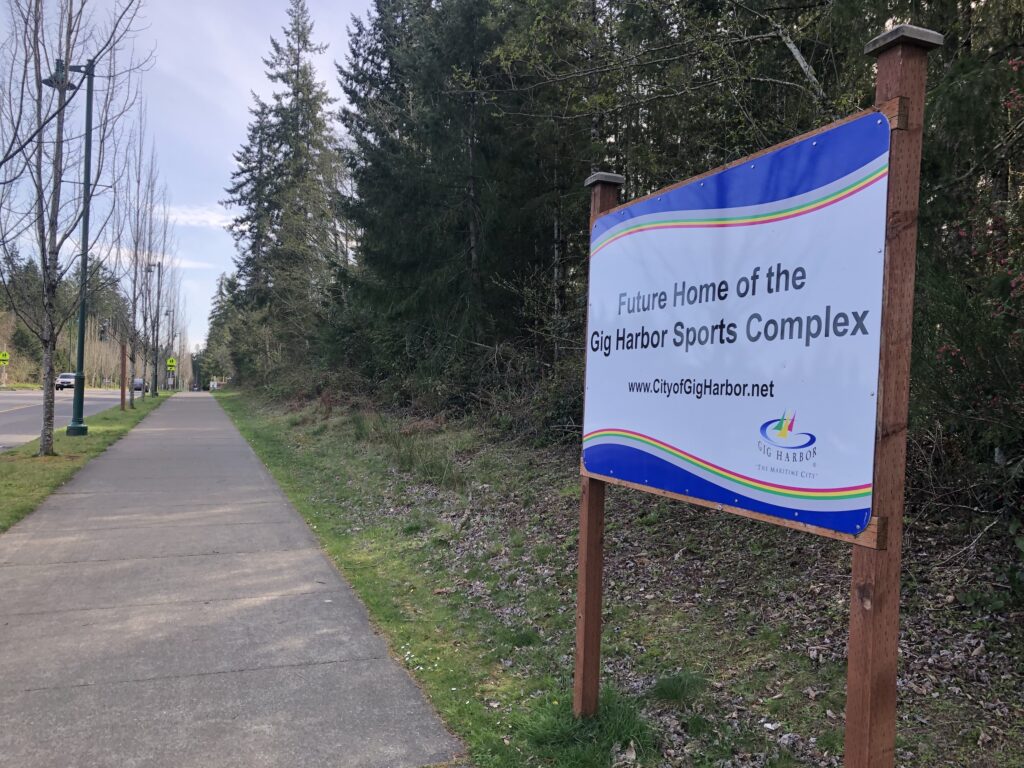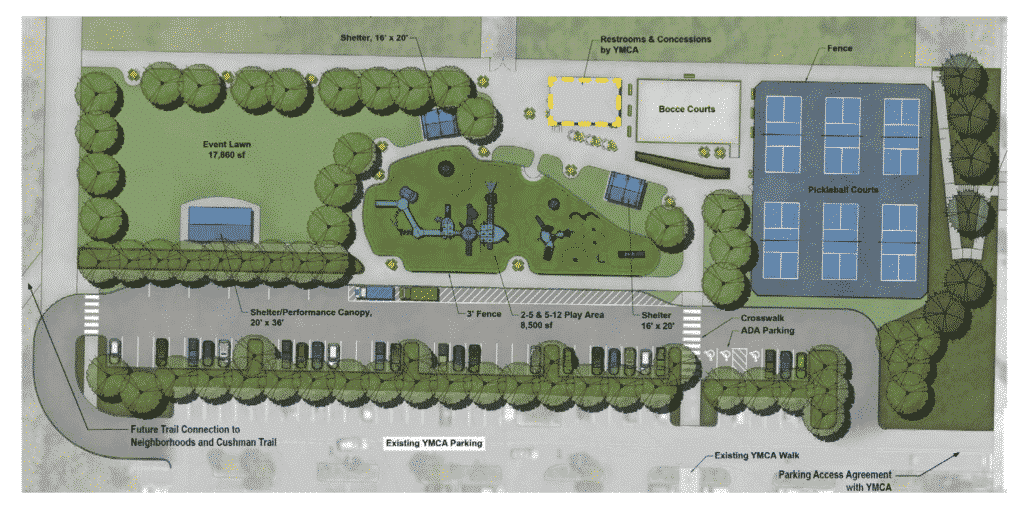Community Environment Government
Neighbors of proposed sports complex want to know its impacts
A group of Gig Harbor North residents is circulating a petition urging the city of Gig Harbor to conduct environmental studies on the effects that a proposed sports complex would have on the surrounding community.
The facility would be built in phases on 30 acres along Harbor Hill Drive, to the north, south and southwest of the Tom Taylor Family YMCA. It would eventually comprise six lighted ballfields with associated parking lots and access roads, among other amenities. Impacts cited in the petition are traffic, tree removal, light and noise pollution, and wildlife habitat destruction.
The City Council on March 28 approved a nearly $600,000 contract with BCRA for design, permitting and bid support of the initial work — Phase 1B.
Phase 1B, on 3.4 acres north of the YMCA parking lot, will include three bocce ball courts, six pickleball courts, two playgrounds, an event lawn with a covered stage, two picnic shelters, and a restroom/concessions building. Design and permitting is scheduled to be completed this year with construction beginning early in 2023.
The city’s 2022 budget allocated $1 million for Phase 1B: $200,000 from a Land and Water Conservation Fund grant, $200,000 not yet awarded from a Washington Wildlife and Recreation Program grant, $400,000 from the Hospital Benefit Zone and $200,000 from park impact fees.
Impact statements
The contractor, among other things, will determine what kinds of environmental impact statements will be needed, conduct a traffic study and an analysis of light, noise and other environmental issues, and prepare a tree survey and a binding site plan for all nine sports complex parcels.
The environmental measures included in the BRCA contract don’t satisfy the petitioners. They’re asking for an independent specialist to study the cumulative impacts of the entire project instead of phase by phase.
“The most important thing, and what the petition calls for more than anything else, is that the impacts be studied as a whole, because right now the way the council has structured it, each phase will have its own impact statement,” said Marilyn Colyar, one of about eight Heron’s Key Retirement Community residents comprising the group’s steering committee. “We’re basically saying before the plan goes forth there needs to be impact studies on the whole (project), not just one phase at a time. To add to that, that the environmental impact studies be done by a neutral agency with that specific expertise, not the construction company who has the contract. We see that as a conflict of interest.”
That’s not how it works, said Mayor Tracie Markley. BCRA will operate as a coordinator, like a general contractor, and sub out studies to appropriate companies. Their work will have to be approved by various governmental agencies. Site plans will outline ensuing phases, but details from future residential and commercial development and from Phase 1B itself won’t be known until later.
“We can’t do environmental studies on those phases yet,” she said. “We have to do them one at a time. You can’t possibly forecast what the environmental impacts for Phase 3 are going to be when it’s seven years out from now. … That’s not how anything works anyway. You don’t future forecast years and years down the the road. It’s not possible. Agencies won’t even do that.”
Project in three phases
The city and YMCA signed a lease agreement in 2021 in which the YMCA became responsible for Phase 1A. It will raise about $6.8 in donations to build and operate two new lighted, artificial-turf fields abutting Phase 1B, as well as construct 100 parking stalls and the restrooms/concession stand building.
Under the terms, the YMCA has until spring 2023 to raise the funds and begin construction, which must be completed by December 2024. The fields will be open to the public when not reserved for sports practices, games or other events. The city will allocate a $350,000 Recreation and Conservation Office Youth Athletic Facilities grant toward Phase 1A.
Phase 1C would add parking and an access road to the west of the YMCA parcel. In Phase 2, the existing city-owned Little League baseball fields would be reconfigured and surfaced with artificial turf to make them suitable for year-round, multi-sport play. Phase 3 would add two more lighted, artificial-turf fields to the south of the YMCA.
Increased traffic is a major concern of the group. Harbor Hill Drive, which had dead-ended near the YMCA, became an arterial in 2018 when it was extended to Burnham Drive. Swift Water Elementary School opened across the street from the YMCA last fall.
The sports complex will add 360 parking spaces to the 490 already at the YMCA and 160 at the Little League fields and along McCormick Creek Drive, for a total of 1,010. The Village at Harbor Hill shopping center is planned at Harbor Hill Drive and Borgen Boulevard with 14 buildings and 577 parking stalls.
Traffic concerns
The petition states that any previous traffic impact studies must be updated to include the new parking and future development on the east side of Harbor Hill Drive.
“It will be significantly busier,” Colyar said. “We can even envision in the case of a large soccer tournament the neighborhood streets being impacted by parking.”
Much of the 30 wooded acres would be logged. That would degrade the rural character of Harbor Hill Drive, increase stormwater runoff, destroy wildlife habitat, reduce carbon dioxide absorption, and increase noise from local roads and Highway 16, according to the petition.
“Trees, that’s a huge issue,” Colyar said. “One of the reasons we want this holistic study to be done is that clear-cutting of trees is going to begin rather soon. The trees are vital for CO2 absorption, most particularly for wildlife because that area is so rich in wildlife. All you have to do is walk around that pond, which we do frequently, and see several varieties of ducks, herons, redwing blackbirds. It’s a rich wildlife area.”
The six sports fields, parking lots and access roads would create excessive noise and light pollution for nearby residents, the petition states.
The group is not opposed to the sports complex, but it wants the impacts to be taken into account and the plan perhaps altered to lessen the impacts and maintain the neighbors’ quality of life, including walking trails with wildlife and trees, and nights undisturbed by lights and noise, Colyar said.
“What we don’t want to do is come across as being anti-family and anti-kid because that’s not the case at all,” she said. “We believe kids should have places to play. Children have to have sports. They need to play soccer. They need to play baseball. We don’t want to come across as being anti-sports, anti-children, anti-family, but we do want the city to be mindful and intentional about studying impacts before going ahead with the grand plan.”
‘Gig Harbor is going to change’
Colyar snapped a photo of a sign with a Martin Luther King Jr. quote recently while vacationing in Pasadena, Calif. It states, “Our lives begin to end the day we become silent about things that matter.”
“This matters,” she said. “This is important, and what happens up here (in Gig Harbor North) matters to every single person who lives here, not only the neighborhoods but everybody in Gig Harbor.
“Gig Harbor is going to change. It’s not going to stand still and remain a little fishing village, but the changes inherent to a growing city have to be planned, with preservation of open space and wildlife and trees being considered an important value.”

Phases 1A and 1B of the sports complex will be between the YMCA and Costco on Harbor Hill Road. Ed Friedrich / Gig Harbor Now
Markley said the group’s environmental concerns will be addressed, and she apologized for a lapse in communication the past two years because of the pandemic.
Many people have moved to the area since much of the planning was conducted and aren’t familiar with the sports complex. They’ll soon have opportunities to catch up. An open house is scheduled for May 7, time and place to be determined, to be followed shortly thereafter by a public meeting at which residents can learn about how the project got to this point, ask questions and make comments.
“We’re now in a new campaign of educating the community about the timeline, how this all came to be, all of that,” Markley said. “We’re hoping the community understands where the project started, why it is so important and be informed better than they ever have in the past. We’re committed to communicating with citizens on this project all of the way through. Now that I’m here (she became mayor in January), I want to make sure that our city and this council in particular is very, very much in support of total transparency to the community in everything we do, especially with a project this big. But this is a project that is going forward. Phase 1 is going forward. There is no question about that.
“The ultimate message is we’re excited about this, the YMCA is excited about it, the council is fully supportive and we are moving forward on Phase 1. We’ll be doing everything by the book. All of the studies need to be done. We’ll be sharing the studies with the community. They will be informed every step of the way.”
Petitions and comments
The group began collecting signatures on Tuesday and expects to present them to the City Council at its April 25 meeting. Petitions can be requested at [email protected]. Photos can be taken of the petition with a person’s signature and address, and emailed to that address, or for instructions about where to drop it off.
Community members can each speak for three minutes at the council meeting, or five minutes as a group. Council members can’t answer questions. They can participate in a two-way conversation at the open house or public meeting, or arrange a meeting with city staff, Markley said.


